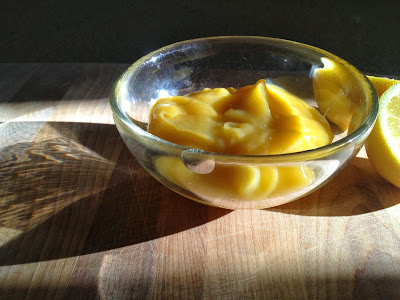I know, I know. I am totally off schedule. Right now I should be posting healthy, fresh recipes for getting back into shape for the new year. Instead I am writing about this delicious, lemony cookie. But I made a promise to my friend Clythie (who recently started her own blog about running and cooking called Run Cook Eat Repeat), and dammit I will keep my promises, even though it may take a while.
I made a batch of these cookies for a cookie exchange a few weeks ago. When I had finished the lemon curd to fill in the center of the cookies, I was so enamored of the glorious yellow and the sweet, tart, and fresh scent of lemon, I decided I had to get a picture of the stuff to spiff up a blog post and to brag on. Of course, this happened:
Argh! Catastrophe!
But then I had to admire the rather pleasing effect of the splatter pattern. And that lemon, placed just so! (It really landed just like that.) When I posted the photo on Facebook, a friend commented that the white sock disturbed the composition, and I agreed. For better effect next time, I need to coordinate my clothes to amp up the contrast (perhaps a blue sock?). Anyway, I had to laugh because the vanity of trying to get a good picture of this glorious lemon curd ended up in a big mess.
About 24 hours later, I had more lemons, made another batch of curd, and baked the cookies. And I finally got a good picture of the curd, which is like sunshine in a bowl, perfect to light up deepest, darkest winter. And the cookie tastes that way: the sweet, sour, fresh bite of curd paired with sweet, crispy cookie.
The recipe for these cookies comes from The All-American Cookie Book by Nancy Baggett. I gave the book to my husband for Christmas in 2001 (I wrote an inscription on the inside cover). I've made a lot of the cookies in this book, but this one may be my favorite.
Ingredients
For the curd:- 2 large whole eggs
- 2 large egg yolks
- finely grated zest of 2 large lemons
- 1/2 cup lemon juice
- 1 cup sugar
- 1/4 cup (2 oz) unsalted butter, cut into chunks
- 2 2/3 cups all-purpose flour
- 1/4 tsp baking powder
- 1/4 tsp teaspoon baking soda
- 1/4 tsp salt
- 1 cup (8 oz) unsalted butter, softened
- 2/3 cup sugar
- 1 1/2 tsp finely grated lemon zest
- 1 large egg
- 2 1/2 tsps vanilla extract
- 2 Tbsps fresh lemon juice
Instructions
For the curd: In a heavy, nonreactive (non-aluminum, typically) pot, combine the curd ingredients. Whisk continuously while bringing the curd to a boil. Let it boil for a minute (keep whisking). Then remove the pot from the heat and keep whisking for another 30 seconds. Strain the curd (you may need to help it along through the strainer with the back of a wooden spoon) and let it cool completely. The curd can be made up to 4 days ahead of time.For the cookies:
- Preheat the oven to 350 degrees.
- Prepare baking sheets (grease or cover with parchment paper or silpats).
- Combine flour, baking powder, baking soda, and salt in a large bowl. Make sure everything is evenly mixed together.
- In a stand mixer, beat together the butter, sugar, and lemon zest until it's very light and fluffy.
- Add the egg, 1 tablespoon water, vanilla, and lemon juice to the sugar-butter mixture. Keep beating until these are thoroughly mixed in.
- Reduce the speed to slow and mix in about half the flour mixture. Then slowly add the rest of the flour mixture until evenly incorporated.
- Shape the dough into a little ball (about 1 1/4 in) by rolling a piece of it in the palms of your hands. (Using a small scoop would be useful here to keep the balls evenly sized and the right size; I always make these too big!)
- Place the ball of cookie dough on the cookie sheet. With your thumb, press into the center of the ball until a well is formed and the dough sort of flattens out into a cookie-like shape. Don't push all the way through the dough.
- Place about 3/4 tsp of the lemon curd in the well.
- Repeat until you have used all the dough. (You may have some curd left over. Like I said, I always make these too big, so I end up with a lot of leftover curd. But you could put that on toast, or cake, or something. Or eat it with a spoon. Whatever makes you happy.)
- Bake the cookies, one sheet at a time, for 10-13 minutes. Turn the baking sheet about halfway through the baking time so that the cookies bake evenly. Let them cool on wire racks.
- Nancy Baggett warns that these cookies should be eaten fairly quickly because they grow softer after a few days. So far that hasn't been too much of a problem.













